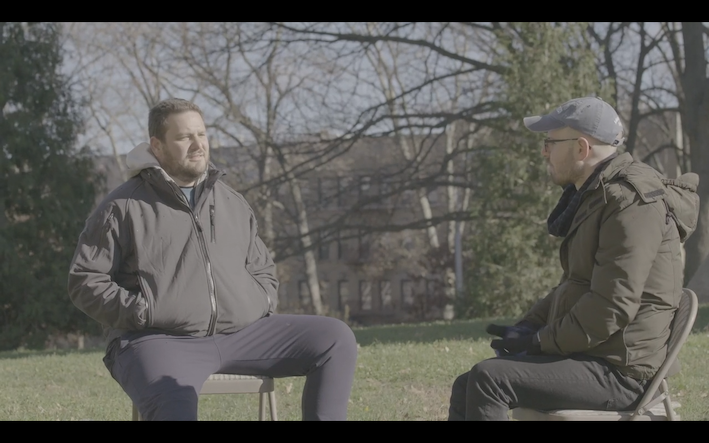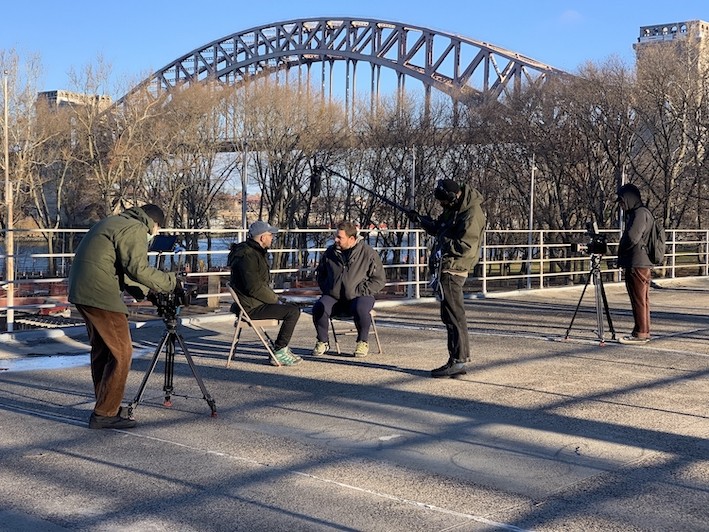Behind the D4: ‘How to Bury Your Mother During a Pandemic’
Behind the D4 is an interview series about the D4 films made by Film MFA Program students. After completing their Directing IV coursework, each student is required to direct a short final project, called the “D4 Film.” Because of the COVID-19 pandemic, films that would have been filmed during the Summer of 2020, began shooting in September 2020.
How to Bury Your Mother During a Pandemic
A partially animated documentary about the surreal experience of dealing with the death of a loved one during the COVID-19 pandemic. In a series of early morning walks, the filmmaker and his childhood best friend talk about the strange and often funny process of putting your mother’s body in the ground while trying to avoid a deadly virus.
Cast and Crew
Writer and Director: Ethan Mermelstein
Producer: Kristin Kohlmeyer
Director of Photography: Dong-Ren Hong
Sound: Rider Laskin
Assistant Camera: Yi Chiang Lin
Cast: Eric Freeman, Jordan Freeman
Is there anything you wish you had done differently?
After the first two days, I was panicked that we didn’t have a cohesive film. I was then very focused on the idea of getting Eric to a place where he could cry and I became a bit obsessive about it, to the detriment of being open through much of the process.
I’ve had a type of project where I’m in it, playing a character that’s a heightened version of myself, the nightmare version of myself—a very self absorbed, selfish, success-at-any-cost person who as a viewer I hate—and I found myself slipping into that character here. because I thought that the movie needed that in some way, injecting chaos when maybe that wasn’t called for. That was also a challenge, finding myself writing the movie while directing it. It’s my first documentary, but I believe an adjustment would be to be open, just receiving, not being so panicked about every moment being tense and dramatic.

You planned to use animation Eric created prior to the film to structure the documentary. Is that still working?
We’re not sure to what extent, if any, we’re going to use animation. It explodes the budget in a way I didn’t realize, but also the footage doesn’t really ask for it right now and I don’t want to shoehorn in animation, but I’m still open to it and considering it.
[Producer] Kristen Kohlmeyer worked for Kirsten Johnson as part of the impact campaign for Dick Johnson Is Dead. She got a recommendation for an editor for us, who’s truly amazing. It’s the first time I’ve edited with an editor, we have around 10 hours of footage. My tone is weird and specific and doesn’t work for everybody, but she actually nailed it. Based on her assessment, she agreed animation wasn’t really necessary right now.

Do you have any advice for anyone looking to tackle such emotional chapters through the documentary form?
I think that you have to be transparent with the people you are working with. Up until this project, I’ve felt comfortable exploiting myself, that’s why I’ve been in a lot of my work. I’m comfortable with tearing myself apart, showing myself in bad light, I think the bad often makes a more interesting film but when you’re collaborating with somebody else, they have to be totally on board. I think of Eric as a true collaborator in this project, even if we didn’t co-direct the movie he’s essentially a producer. If you’re going to expect your subject to give of themselves in that way, they have to get something out of it, they have to be feeding the project knowingly and consensually. I think documentaries are a dangerous form because it’s so powerful. It’s about “bringing the people in” instead of “looking at them.”
Read more from the "Behind the D4" series here.
